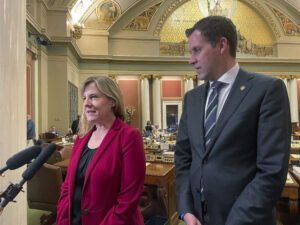It’s Time for Term Limits for U.S. Justices
Term limits could be a big improvement for the Supreme Court. Life tenure is a relic of a time when life was a lot shorter.Not that it’s going to happen, but the retirement of Justice John Paul Stevens and the focus on the age of President Barack Obama’s pick to replace him have gotten me thinking about term limits for Supreme Court justices.
I’m for them.
Let me hasten to say: This is no reflection on the retiring justice. Some have overstayed their time on the court, lingering past the point of productivity; Stevens is the counterexample. I can only hope to be nearly as sharp and energetic at 70 as he is at 90. I know my tennis game won’t be nearly as good.
Rather, I’m prompted by the discussion of the need for Obama to select a justice young enough that he or she will be able to serve for decades. One of the rumored contenders, federal appeals court Judge Merrick Garland, is 57. Another, Diane Wood, turns 60 on July 4. Does their age make them past the optimal appoint-by date? Does it give a leg up to Solicitor General Elena Kagan, about to turn 50? Any of the three would be a terrific justice, but it’s ridiculous that the current system creates a perverse incentive to overvalue younger candidates.
As a general matter, lifetime tenure for judges is not only a good idea, it’s essential to an independent judiciary. As a general matter, term limits for public officials are a bad idea; they deprive the public of wisdom born of experience. But for the Supreme Court, term limits could be a big improvement. Life tenure is a relic of a time when life was a lot shorter.
First, for the reasons already described, well-qualified candidates are disadvantaged at the height of their careers. Second, the combination of lifetime tenure and growing life expectancy leads to a geriatric court, at times problematically so. According to figures compiled by Northwestern University law professors Steven Calabresi and James Lindgren, the average age of Supreme Court nominees has remained steady at about 53 over time while their average tenure has grown by more than a decade in recent history. From 1789 until 1970, judges served an average of 15 years. From 1970 until early 2005, the average tenure expanded to almost 26 years. The four justices leaving since then (including Stevens) had served an average of 28 years.
Third, and related, the increasing tenure means a court that can go long periods with almost no turnover. Until the departure of Chief Justice William Rehnquist in 2005, the court went through an 11-year stretch without any change in its membership. This is unhealthy for any democratic institution. Fourth, the absence of term limits creates a kind of presidential lottery in which some presidents (Jimmy Carter) get to pick no Supreme Court justices while others have multiple appointments (Richard Nixon had four). Fifth, fixed limits prevent justices from gaming their departures to give the pick to a president of their political persuasion.
Citing foreign law is a controversial practice these days, but no other major country gives life tenure to its equivalent of Supreme Court justices. Neither do any of the 50 states. A term limit of 18 years, phased in over time, would mean that Supreme Court vacancies would open up once every two years.
Most discussions of Supreme Court limits have assumed that a constitutional amendment would be required to accomplish this change. But an ideologically diverse group of law professors last year proposed a legislative solution that’s worth more discussion than it has generated.
The first time I heard the notion of term limits for Supreme Court justices, I thought it sounded vaguely un-American. The more I think about it, the more I am convinced it would make America better.
Ruth Marcus’ e-mail address is marcusr(at symbol)washpost.com.
© 2010, Washington Post Writers Group
Your support matters…Independent journalism is under threat and overshadowed by heavily funded mainstream media.
You can help level the playing field. Become a member.
Your tax-deductible contribution keeps us digging beneath the headlines to give you thought-provoking, investigative reporting and analysis that unearths what's really happening- without compromise.
Give today to support our courageous, independent journalists.









You need to be a supporter to comment.
There are currently no responses to this article.
Be the first to respond.